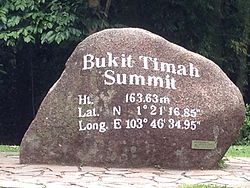Bukit Timah Reserve
The Bukit Timah Reserve ( English Bukit Timah Nature Reserve or Bukit Timah Natural Resort ) is a reserve within Singapore , about one kilometer north of the Bukit Timah district, consisting of partly primary rainforest to thinned secondary forest . Only in Rio de Janeiro is there a second time on earth a primary rainforest within the city limits. The 164 hectare reserve is 12 kilometers from the city center. The highest point is the Bukit Timah ( malaii. "Tin Mountain ") with 163.8 meters. The volcanic granite rock was formed 200 million years ago in the Early and Middle Triassic .
The conquest of the district of the same name by the Japanese armed forces brought the final turning point in the battle for Singapore and led to the surrender of the British.
Today the reserve is a local recreation area that is visited by the population especially on weekends and holidays. Several hiking and mountain bike trails are marked. In the south there is a visitor center, near the former, now full granite quarry, Hindhedge Quarry .
biodiversity
Founded in 1883, originally a botanical plant collection for more than a century, the Bukit Timah Reserve can now boast 912 plant and 98 animal species. Botanically, it is a coastal mountain Dipterocarpus forest, which includes 18 different species of the Dipterocarpaceae up to 80 meters high , among others from the genera Shorea , Vatica and Hopea . Mainly Shorea curtisii and Dipterocarpus caudatus subsp. penangianus . The hard and heavy wood of the "Tempinis Tree" ( Streblus selongatus ) was an important material for the island, after which 37 streets and the city of Tampines are named. Parquet flooring, door and window frames are still made from it today; however, the wood is imported today. Also Rattan lianas ( Korthalsia scaphigera ) are found in the dense forest. The jungle meets all the requirements for a primary forest with well-grown secondary forest , even if it is interspersed with a network of partially concrete paths.
One of the common insects is the green cicada Dundubia sp. and Purana tigrana , the males of which make clearly audible sounds, and the ant species Camponotus gigas . The butterfly Idea stolli logani (“Common Tree Nymph”) with black dots on a gray-white-bluish background can be seen frequently, and more rarely the small, brightly colored “Branded Imperial” Eooxylides tharis distanti .
The bird's nest fern ( Asplenium nidus ) and the antler fern Platycerium coronarium can be seen as epiphytes in the higher regions. The "Peacock Fern" Selaginella willdenowii is also widespread , with some leaves often shimmering metallic blue. The fern Dicranopteris curranii ("Resam fern"), which forms hexagonal geometric patterns with its shoots, spreads very aggressively through human influence, suppresses other plant species and is therefore regularly weeded.

Some shy snakes like the Paradies chrysopelea ( Chrysopelea paradisi ) and the reticulated python ( Python reticulatus ) populate the area, but are rarely seen for visitors.
Nectar birds such as the green-backed nectar bird ( Nectarinia jugularis ) can be observed on flowers. They have undergone a convergent evolution analogous to the hummingbirds in the New World and are masters of the soaring flight . They occur as far as the Philippines . A “talking” bird popular in Asia, the Beo ( Gracula religiosa ), can also be found in the reserve. He irritates both other birds and visitors by imitating calls; he imitates cell phone ring tones, coughs and laughter, a few words and short sentences. One of the most widespread birds in the reserve is the flag rongo ( Dicrurus paradiseus ). Its divided long, narrow tail feathers, which terminate in oval, decorative feather surfaces, are reminiscent of a bird of paradise , but the drongos form a family of their own. The sky-blue back with a black underside is characteristic of the blue elven bird ( Irena puella ). The fire-backed woodpecker ( Dinopium javanense ) can be recognized by its bright red head.
Only a few mammals are still listed, including the long-tailed macaque , which can often be found on the hiking trails and in garbage cans. A burglar-proof locking system was developed especially for him. The Malay gliders ( Cynocephalus variegatus ) are seldom to be seen, whereas more common squirrels like the banana squirrel ( Callosciurus notatus ) and the Sunda squirrel ( Sundasciurus tenuis ). The Malay pangolin ( Manis javanica ) is very rarely seen. Until the beginning of the 20th century, tigers ( Panthera tigris ) still lived in the vicinity of Bukit Timah , until the last tiger was hunted on October 26, 1930.
literature
- A Guide to Bukit Timah Nature Reserve Trail published by the National Parks Board ( PDF file )
Web links
- Detailed travel description for Singapore and the Bukit Timah Reserve with information on biodiversity, tours, arrival and departure
- Green-backed nectar bird being rearing near the Singapore Bukit Timah Reserve
Coordinates: 1 ° 21 ′ 10 ″ N , 103 ° 46 ′ 42 ″ E

